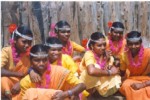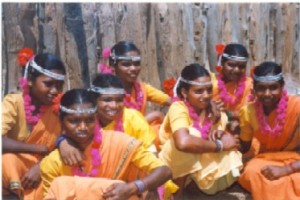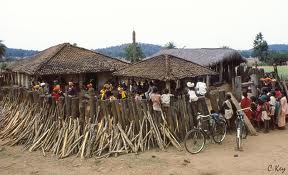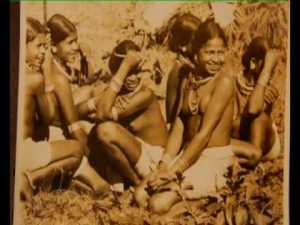When one thinks of India, they do not think of casual sex or open sexuality, especially pertaining to the unmarried youth. Sex in India is not usually an open subject; public displays of affection are often looked down upon and in other parts even illegal.
Can you imagine a culture in India where the youth are given years of their life to explore sexual freedom? Well, it exists in Bastar, India. The Muria Tribe support sex among their youth. The indigenous people of the Muria tribe are a sub-caste of the Gond Tribe, living on the plains of the Narayanpur and Kondagaon Tehsils.
To the outsider they may seem like a normal indigenous tribe, living in simplicity off of the land and partaking in ritual dance and music. While that remains true of the Muria people, they are unique in their construction of an institution referred to as a Ghotul. This is an environment created for the tribe’s youth. Ghotul life has its own reality; it is a time for the youth to experience the challenges of growing up without the pressure of an outside world.
This institution is entirely created for the youths benefit. Their happiness is treasured among all else in Muria society. Human compassion and unity gained by the youth is the meaning behind Ghotul life. Ghotul life is of most social importance to the members of the Muria tribe.
Indigenous Lifestyle:
The Muria tribe would not stand out if it were not for the institution of the Ghotul. They live a simple life, based on hunting and farming. Just like all indigenous tribes in the area, they grow vegetables, rice, and are sustained by the earth. The women usually do the farming, while the men go hunting in the forest using bows and arrows.
The Muria tribe are so connected to the earth and ways of tribal life that they, “harvest herbs from the forest to make contraceptive potions and preparations for the treatment of sexually transmitted diseases” (Orr, 2005). The Muria tribe lives in honor of their land.
Ghotul Life:
There is no English translation for the world “Ghotul” but as David Orr describes, “For the tribes young people, the ghotul is at once a commune, dormitory and nightclub” (2005). Taking place only at night, the youth come together to partake in traditional story telling, dance, singing, and of course, sex. Older members help guide the younger members in how to behave and engage in sexual practices. However, sex is never forced upon the youth if they do not feel ready.
While this may seem like a sexual free for all it is not. There are many guidelines that one must follow in the Ghotul. “No boy (chelik) or girl (motiari) may sleep with the same person more than two or three times in a row. Rather, they must regularly change sexual partners and no-one, no matter what their looks or popularity, should get preferential treatment” (Orr, 2005). Ghotul is seen as a time for the youth to enjoy their peers without concerns of the outside world, a time of true happiness.
The ghotul is a large hut made up only of materials from the earth. There are two kinds of huts; a Sar, which is for group congregations, and a Bhitar, also known as the sleeping, quarters. “The floors of both were smoothed with dried cow dung and were empty of beds or furniture” (Orr, 2005).
The benefits Ghotul Life:
Many people will find faults in the actions of Ghotul life, seeing it as immoral. However, there are many people that understand it as a positive aspect of a child’s life. Most importantly, the individuals who graduate from Ghotul refer to it as the happiest times of their lives.
The lessons that the youth learn throughout their time in Ghotul can be seen as important lessons for youth around the world. It not only promotes a healthy attitude towards sex, but also allows children to learn how to conduct relationships and friendships in a healthy way.
They learn not to allow jealousy and fighting into their lives. The spirit that is said to project from the Muria people is one of true kindness, love and appreciation. These are all attributes that are gained through Ghotul life. Ghotul life is also seen positively in preventing divorce and unhappiness in later adult life. (Elwin, 1968)
Western society has constructed a notion that sex pertaining to the youth is outrageous, but what if we learned to look at it through the lens of Ghotul life? Instead, teaching our youth about unity and happiness among each other.
Tourism/Modernization:
There is a big reason that the Muria tribe has stayed a secret to most of the western world. There is a Maoist rebellion that inhabits the surrounding forest of the Muria land, better known as the The Naxalite Guerilla. They have made it almost impossible for researchers or tourists to enter the forest. Many of the locals no longer enter the forest, knowing they would be killed or captured. (Orr 2005)
Like most religions, cultures, and indigenous tribes, modernization is changing the way of life and making it hard for them to stay alive. The Muria tribe has changed over time in part to the westernization of India and in part because many saw the Ghotul as immoral. However, many Murai are still standing strong.
The Muria may not appear to be as indigenous as before, they now wear more traditional Indian clothing, partake economically in local markets, and some youth are even seeking jobs outside of their land. However, their rituals and institution of Ghotul life have stayed the same. The pressures of the outside world are making it difficult for the Muria people to ignore. Will this tribe continue to ignore the modernity forming around them or will they succumb to ways of the western world? … I guess we will have to wait and see.
By Emma Ravdin
Sources:
Orr, David. 2005.”In Search of the Muria Code.” Geographical (Campion Interactive Publishing) 77(3):56-63. Retrieved September 20, 2014 (http://eds.b.ebscohost.com/ehost/pdfviewer/pdfviewer?sid=14227d3e-77fb-4d21-866d-72035129c5a1%40sessionmgr198&vid=0&hid=104).
Verrier, Elwin. 1968. The Kingdom of the Young. Apollo Bunder, Bombay India: Oxford University Press.




